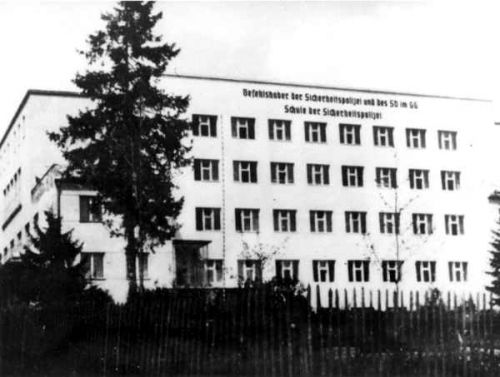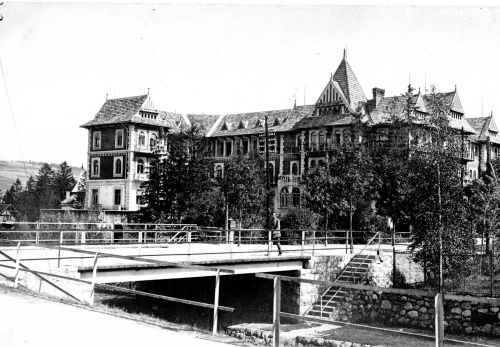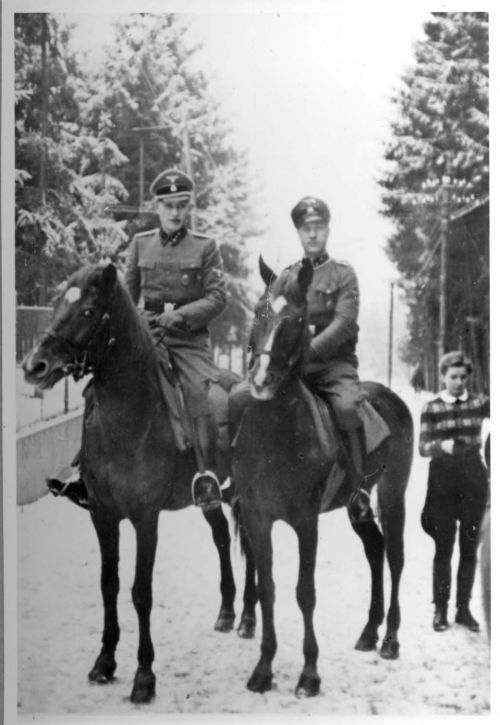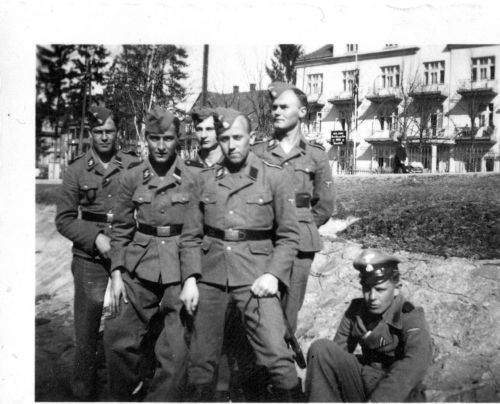Bad Rabka and Zakopane SIPO Schools

Bad Rabka - SIPO School in 1942 (Yad Vashem)
During the first few months after the occupation of Poland SS-

Zakopane - Hotel Stamary (Chris Webb Private Archive)
The purpose of the SIPO-SD School was to train selected candidates of the SIPO-SD, SS personnel and Ukrainian Nazi sympathisers and the school was headed by Hans Krüger. On April 20th, 1940, SS-Oberscharführer Wilhelm Rosenbaum was appointed Police Secretary at the school and deputy to Hans Krüger. His duties were more of a domestic nature, arranging board and lodgings, salaries, looking after the welfare of the conscripts and other general administrative duties. Among the other permanent staff were the brothers Wilhelm and Johann Mauer. The brothers once officers in the Polish Army, and who spoke Ukrainian, were enlisted to train and instruct the Ukrainian candidates. Their sister Lisa Schumacher performed office work. The kitchen and feeding arrangements were organised by local Polish personnel.
Through an intermediary of the Judenrat SS-Oberscharführer Wilhelm Rosenbaum selected male and female workers from the Jewish population for maintenance and cleaning work, care of the garden and other manual tasks. The Jewish man, Paul Beck, was appointed overseer of the Jewish workforce. With his experience in practical things, cunning and his abilities with languages, knew how to conduct himself and mediate between the Jewish workers and the SS. Rosenbaum always turned to Beck whenever he needed foodstuffs or other goods. When in July 1940, the SIPO -SD School and its permanent staff were about to be moved to Bad Rabka, a number of Jewish workers, including Beck, were selected to move to the new location.
Bad Rabka was a small health resort located both sides of the River Raba and was halfway between Krakow and Zakopane. At the outbreak of the Second World War there were approximately 7,000 inhabitants in the town. The Jewish population was approximately 1,500, which increased during the initial phases of the war. Relatives and friends of the local Jews moved to Bad Rabka, from the larger towns, in the hope of being less exposed to persecution and ill-treatment.
A number of offices and organisations of the Reich and Wehrmacht established themselves in Bad Rabka. Apart from the local Commander's office and the government departments, there was a military convalescent home, children's homes and a German guest house. Bad Rabka had all the trappings of a small town, served well by both road and rail. The adjoining railway station of Chabowka, a central junction for larger towns in Poland, also served Bad Rabka.
The SIPO -SD School initially occupied premises of a requisitioned Jewish religious institution for children, situated near the Chabowka railway station. In late autumn 1940, the School moved to new and much larger premises to the 'Theresianeum' - also called 'Thereska' - a high school for girls. The four -storey building was located in the northern part of the town called Slonna, on a tree covered slope alongside the River Slonka, which flowed into the River Raba.

Rabka wartime postcard with the School pictured at the right (Chris Webb Private Archive)
Hans Krüger remained at the SIPO -SD School until July 1940, when he was recalled to Krakow to take up duties as deputy to SS-Standartenführer Dr. Karl Eberhard Schoengarth, Security Police Commander for the Krakow District. For a short period SS-Hauptsturmführer Rudolf Voigtlander tookover, but within a few weeks Wilhelm Rosenbaum was appointed Commandant of the School, where he remained until April 1941, when he was also transferred to Dr. Schoengarth's office for preparatory work for the implementation of 'Barbaossa,' the German invasion of the Soviet Union. The SIPO -SD School activities were suspended, but retained a small staff to look after the premises. The School did not recommence activities until November 1941, when both Rosenbaum and Dr. Schoengarth returned from service in Lvov.
Within days of the Rabka School becoming operational again a large black flag and a swastika was prominently mounted on the roof and a large black inscription was displayed across the top floor of the building. It read 'Befehlshaber der Sicherheitspolizei und des SD im GG Schule des Sicherheitspolizei.'
To encounter their military move into the Eastern Territories, the SIPO -SD School curriculum was updated to reflect the new duties. Selected candidates were nominated from a wider range of sources, although still mainly from German security establishments, Waffen-SS, and the civil service throughout the Reich. Pro-Nazi Poles and Ukrainians were also open for selection for Police Training as well as the so-called V- Manner (undercover agents). The Rabka School had continued with specialist instructors such as the Mauer brothers, who remained in Stanislawow, with Hans Krüger, and were replaced by Ukrainian -SS, Wosdolowicz, Jaworski, and Vasilko who took charge of the Ukrainian candidates.
The Organisational Structure - Bad Rabka
'Befehlshaber der Sicherheitspolizei und des SD (BdS) Krakow, SS-Oberführer Schoengarth overlord of the Training Establishment at Rabka
Division of Exam Study and the engagement of lecturers under the direction of SS-Oberscharführer Wilhelm Rosenbaum:
1. Organisation and Law
A. Legislation
B. Indemnification
C. Reich Defence
D. Confiscations
E. Passports
F. Budgets
G. Technical Matters
2. SD- Inland
A. Legal Practice
B. Ethnos
C. Culture
D. Economy
3. Gestapo
A. Border Police
B. Enemies
C. Communism
D. Sabotage
E. Liberalism
F. Assassinations
G. Sects
H. Catholicism
I. Protestantism
J. Freemasonry
K. Evacuations and Jews
L. Card Files
M. Spheres of Influence
N. Counter Intelligence
O. Treason
4. Kripo
A. Policy
B. Crimes
C. Identification
D. Kriminal Institute
5. SD-Foreign
A. General
B. German - Italian Sphere
C. Russo- Japanese Sphere
D. West
E. Investigation
F. Technical Matters
6. Ideology
A. Evaluation -Jews

Wilhelm Rosenbaum (left) at Bad Rabka 1942 (Yad Vashem)
Prospective candidates for non-commissioned courses were required to be healthy men between the ages of eighteen and thirty-five, were ranked and segregated according to their standard of education. Johann Bornholt, an ethnic German was inducted into the School, but was soon found to be below the educational standard required. Bornholt was transferred to the prison establishment at Nowy Sacs, where he was made a prison guard in the SD security detention block.
Since November 1941, there were a steady stream of German, Polish and Ukrainian candidates passing through the training courses of the Rabka SIPO -SD School. This was in addition to the Senior and Intermediate Command courses, that were continually being held. The length of the courses fluctuated, but usually they were for a month, for the non-commissioned personnel and between 3 and 6 months for the senior commanders. During the early days of the campaign on the Eastern Front, emergency courses were held, but over time, the School settled down to a more conventional syllabus, which continued in this manner until 1944, when the School was transferred to Berlin, due to the Red Army advance.
There were specially designed courses for those involved in 'special aktions' on the Eastern Front, which were the responsibility of SS-Unterscharführer Wilhelm Oder. Although Oder was on Rosenbaum's staff, he was directly answerable to Dr. Schoengarth. He was at the Rabka School from the autumn of 1941, until March 1943, when Rosenbaum left. Oder performed many killings in order to instruct his candidates. He was an expert on the 'shot in the neck' method of execution. He would demonstrate this method to the candidates using his pistol, a Walther PPK , calibre 765, shooting Jews at a distance of 10-20 centimetres. Also used were a various assortments of machine-pistols.
SS-Hauptscharführer Walter Proch was also one of the main instructors at the School and like Oder he trained the candidates in the art of killing and torture. He personally shot many Jews in the School. He shot a Jew in the streets of Rabka because he had a beard. Proch was responsible for many deaths and Jewish witnesses Asszer and Grossbarth Blatt recalled:
'SS-Hauptscharführer Walter Proch - 1942-43, Gestapo officer at the Rabka School - shot 6 people for no reason. In 1942, the transport of Jew-workers from Nowy Sachs: he shot 6 Jews while they were washing, and a further 2 for no reason. On the same day he shot up to 50 Jews in a Rabka 'action.' Blatt personally saw Proch hang a Jewish family, who were US citizens in the woods at a School execution 'action.'
Also on the teaching staff 'SS-Hauptscharführer Alois Bohnert and 'SS-Hauptscharführer Schuppler were members of the permanent staff since November 1940. 'SS-Scharführer Bandura was the School's driver. Dziuba was the clerical officer. The female staff were Meta Kuck, Personal Secretary to Rosenbaum, Schindler and Engelmann, who were also secretaries to Rosenbaum and other senior staff. Many of the teaching staff, were seconded from Berlin and Krakow and were experts in their chosen field SS- Hauptsturmführer Vopel was an expert on Freemasonry. SS-Obersturmbannführer George Schaepel, Head of Section V, BdS Krakau, took the Polish police courses for Criminal Law and Procedure.
Lecturers at the SIPO -SD School came from the elite of the Nazi hierarchy within the Generalgouvernement such as the General-Governor Dr, Hans Frank, Odilo Globocnik, the SS and Police Leader for the Lublin District,Friedrich- Wilhem Krüger, Higher SS and Police Leader East and other Senior SS and Police, such as Julian Scherner, Johannes Müller, Max Grosskopf, Dr. Neidling, Fritz Katzmann, Dr. Helmuth Tanzmann, Hans Krüger and Dr. Karl Eberhard Schoengarth.
Accommodation for Wilhelm Rosenbaum, his guests and visiting lecturers was located in the villa 'Margrabianka' known as the 'Fuhrerheim' situated on the other side of the River Slonka, closely guarded by Ukrainian sentries at all times. A casino was also available for the SS-Leaders and visiting Security Service personnel. A recreation place for the general SS was established in the villa 'Haus Annemarie,' which was managed by Rosenbaum's fiancée Annemarie Bachus.
Once the School had re-opened Rosenbaum established a number of workshops which included; tailor's shop, shoemaker, saddler's and a hairdresser's shop, all manned by Jewish workers under the direct supervision of a few Ukrainians; the brothers Czarnowicki, and the Jew Herman Gold belonged to the Jewish tailors, the Jew Zelinger worked in the saddle- smith's. A Jew Trieger was the Gardner and Michael Ettinger was a locksmith and driver, whose domain was located in the School garage. The Jewess Hela Bauman was brought from Zakopane to work in the laundry. The Jewess Sara Schon and Ada Rawicz were cleaners who worked in the villa 'Margrabianka.' Sara Schon also worked as a maid and nanny in the households of Hans Krüger, Hermann Schuppler, Walter Proch and finally Wilhelm Rosenbaum. Overseer of the Jewish workers and personal interpreter to Rosenbaum was the Jew Paul Beck who lived on the School premises with his son.
Rosenbaum constructed more buildings on the School grounds. He laid out a sports ground and shooting range in the small woods behind the School. Building materials for this construction project came from the Jewish cemeteries in the district. From the Jewish cemetery at Nowy Targ, smooth granite and marble stones were shipped to the SIPO -SD School at Rabka and was used in the construction of the shooting range and the paved area at the front of the School.
Rosenbaum testified in his post-war trial that Jews were brought to the School to be used as 'running targets.' For training on the shooting range, buses laden with children came from Auschwitz, and were released, 'like hares to be shot as moving targets.' Michael Ettinger recalled how, 'Selected Kapos of the Jewish prisoners were regularly ordered by 'SS-Scharführer Bohnert to attend instruction classes, which were usually arranged early in the morning. We were taken to the fields behind the School, where we were given instructions as to how to conduct ourselves when called upon to dig pits. We were not stupid and knew that people were being shot in the woods. At first they told us that the pits were for anti-aircraft purposes, but this lie had no meaning to us. After a time, even the Germans knew these lies were not practical. The pit had to be dug to precise measurements which would be given at the time.
On arrival of the Commandant we had to make ourselves scarce and hide in the bushes with our backs to the pit. On the sound of a whistle we would return to the pit and work to instructions, which meant arranging the dead bodies and then filling in the pits to a level. Of course some of us looked at what was going on: groups of people were brought to the edge of the pit and made to undress. Then they were positioned at the edge and shot in the back of the head. The shouts, pleas and screams were terrible.'
The modus operandi for mass executions by shooting were as follows, as recorded by the events of May 20, 1942:
Wilhem Rosenbaum ordered the Judenrat in Rabka to send at least 45 disabled and elderly Jews to come to the School. Among them there was the mother of the Jewess Nogala- Mrs. Paster, as well as the grandmother of the Jewess Schon- Mrs. Ernestine Kranz, and her uncle -Chaim Beim. After their arrival at the School, the Jews were locked in the bunker, next to the School building, which was guarded by Ukrainians.
That same day, Jewish workers had started to dig a grave at the execution site behind the School. 'SS-Hauptscharführer Alois Bohnert had chosen approximately 20 -25 Jewish workers to fulfil this task. At 5 p.m. the victims locked up in the bunker were taken in small groups by the Ukrainian guards, who were beating them and urging them on to the execution area. The grave-diggers were concealed in the bushes nearby, facing away from the execution site. The Jewish victims were ordered to undress and then to stand or sit around the mass grave. One Jewess who refused to undress had her clothes ripped from her body.
Simultaneously, Rosenbaum arrived with a posse of SIPO -SD men and immediately started the 'action.' Rosenbaum personally shot at least 6 Jews, in the back of the neck, with his pistol. Bohnert, Oder, Bandura and the Ukrainian Wosdolowski all shot Jews into the mass grave. The bodies were arranged and covered over.
In Rabka there was a Jewish family who had the same name as the School Commandant (Rosenbaum). There was a mother, father, and a 15-year-old daughter and son aged about ten years old. Before the war, the mother’s side of the family owned a haberdashery shop near the railway station. Until the German occupation, the father was a ‘driver’ who travelled the country on business.
When the SD School was transferred to Rabka he became a worker in the School where he worked on the small farm and guarded the sheep. Only when the Jewish population had to present themselves in the School, in the spring of 1942, did Rosenbaum noticed that there was a Jewish family in Bad Rabka with his name. He could not stand the thought of this. Well before the war, Rosenbaum realised that he had a name with a Jewish sound and filed an application to change it but was never finalised. It was a standing joke among the School staff who would talk about Untersturmführer Beck (the Jew) and the Jew Rosenbaum (the Commandant).
This was the basis for him being shocked and mad that this family Rosenbaum from Rabka apparently confirmed the Jewish origin of his name. Since the general roll call, family Rosenbaum was living in fear from the Commandant. One day, in the summer of 1942, quite a while before the general deportation of the Rabka community, Rosenbaum killed the family Rosenbaum. In a late afternoon, they, the father, mother, daughter and son were brought to the School.
After the family had been assembled in the School Rosenbaum appeared and rushed at the father, cursing: ‘You damned Jew, with what right are you carrying my good name.’ And he proceeded to beat the father. Rosenbaum called for Scharführer Bohnert and ordered him to shoot the family there and then. The order was carried out immediately in Rosenbaum’s presence. The news of the shooting quickly spread throughout the remaining Jewish community and resulted in an increase of outrage, fear and fright among the Jews.
A few days before Sunday the 30 August 1942, when the deportations took place in Bad Rabka, a new type of execution took place deviating from the now practiced methods.News about a forthcoming deportation had filtered through to the Jewish population. Some Jews, who belonged to the permanent staff at the School decided to escape. Two of the escapees, the brothers Czarnowicki who both worked in the tailor’s shop escaped overnight and managed to reach Krakow.
More Jews escaped which prompted Rosenbaum to close off all other escape routes. The Jewish accommodation, whose 3 houses were situated below the School premises were closed. Based on this development, Rosenbaum decided to put a plan to the test in order to avoid further escapes. About 5 days before the Rabka deportation, directly after the days work, the Jews were ordered to gather for a roll call on open space behind the School. Not less than 100 Jews paraded. In a shed on the building site, at the back of the School, preparations were made for a hanging. Ropes were attached with hooks to horizontal beams. Underneath there were boxes or barrels covered by boards. Apart from the Jews, Rosenbaum, and SS NCO's Bohnert, Oder, Badura, Paul Beck, the Jewish overseer and some Ukrainians were present. Ten Jews were brought to the spot, among them was the young boy Edek Liebenheimer who was Rosenbaum’s ‘boot boy’. Among these chosen Jews was one member of the Judenrat, Simon Zollmann.
The 10 Jews were placed on the prepared barrels and boards and the ropes were placed around their necks. Rosenbaum yelled to the gathered mass that workers had escaped and therefore these Jews would hang in retaliation. The gathered Jews were ordered to look in the direction of the execution place. The boards were pushed from under the victim’s feet so they fell; the ropes tightened and strangled the victims. It didn’t all go according to plan. The Jew Liebenheimer’s noose ripped or he slid through the noose of the rope and he fell on the ground. Liebenheimer tried to escape and when the guards were about to shoot him, Rosenbaum yelled in wild excitement: ‘Do not shoot, hang again!’ Liebenheimer begged Rosenbaum: ‘Mr Untersturmführer, please shoot me!’ Rosenbaum yelled at him: ‘you dog, for you I am not an Untersturmführer anymore, you will be hanged!’ He was hanged a second time. This time, the noose also ripped and he again fell to the ground. The third attempt was successful. The Jews took the victims to the grave in the woods. One living victim, carried by the Jew Kalfus, was shot on the way. Shots were fired in the grave to make sure all were dead. Rosenbaum stayed at the execution place until the end of the hanging action.

SS Troops in Bad Rabka (Tall Trees Archive)
SS-Standartenführer Dr. Karl Eberhard Schoengarth, in Krakow became aware of an SS investigation into corruption and theft, and in order to cover tracks took place and he ordered Rosenbaum to murder the Jewish overseer Beck, who was privy to all the actions carried out by Rosenbaum and other members of the SIPO -SD School. 'SS-Scharführer Bohnert took Beck into the woods and shot him.
During April 1943, Friedrich- Wilhem Krüger, Higher SS and Police Leader East, Dr. Karl Eberhard Schoengarth and Hans Krüger were transferred to Berlin, Greece and Paris respectively. Rosenbaum was also transferred from Rabka to Krakow, and then subsequently to an administration post with the KdS in Salzburg. He performed the duties of an adjutant to SS- Hauptsturmführer Wilhem Teege, arranging courses and making arrangements for those attending. On August 7th, 1943, he married his fiancée Annemarie Bachus.
Back in Bad Rabka, with Rosenbaum transferred, the SIPO -SD School was totally restructured with new personnel. Rosenbaum's place was taken by SS- Hauptsturmführer Fritz Hermann, and courses were continued for SIPO and SD officers, Polish Police and Civil Servants. Bandura, the School Driver, was kept on. Wilhem Teege was transferred from Salzburg to Bad Rabka, and he arrived in the School in August 1943, a few weeks after the deportation of Jews from Rabka to the Plaszow Arbeitslager in Krakow, had taken place.
During mid-1944, due to the Allied air raids on Berlin, training courses from the capital of the Reich were moved to Bad Rabka. The courses and curriculum was geared to Security Services, Police Officers, and Civil Servants who had been earmarked for promotion. The courses lasted for 6 months duration and by all accounts were very selective, and this resulted in a high failure rate. Candidates were tested every few weeks and those failing to pass the tests were removed. As an example, the June 1944's, intake of 68 students, 24 left after the first test, 20 more left after the second test and out of the 24 students who took the final exam, a further 3 failed.
Two men from the Chelmno Death Camp, in the Warthegau, Walter Piller and Wilhem Schmerse attended a course in Bad Rabka, as testified by Walter Piller on May 19, 1945, he recalled: 'Both Kriminal-Sekretar Schmerse and I were not around to witness the liquidation of the Wetterkommando Legath, as we were both sent to the town of Rabka in the Generalgouvernement in order to take a course for SS Commanding officers. Neither of us had completed the course.'
In January 1945, whilst organising conferences in Salzburg, Wilhelm Rosenbaum was selected for a Senior's Inspectors course, in his old hunting ground of Bad Rabka, on January 2nd, 1945, but the course was curtailed on January 17, 1945, due to the advance of the Red Army. Rosenbaum returned to Salzburg, where on April 20, 1945, he was promoted to the rank of SS- Untersturmführer. With the Second World War drawing to a close in April 1945, Rosenbaum moved from Salzburg, to Simmling, where he saw out the conflict.
After the end of the Second World War Wilhelm Rosenbaum found employment as a transport manager for a farm co-operative in the eastern zone. After a brief while he returned to Hamburg, where he tried his hand at several jobs, such as a Private Detective and a Travelling Salesman. In 1949, he took ownership of a sweet shop in Hamburg, and then moved into the wholesale confectionary business, where he was very successful.
Wilhelm Rosenbaum stood trial in Hamburg, and was sentenced to hard labour for life in 1968, for the murder of 168 Jews in the Rabka area of Poland.
Source
Dr. Robin O'Neil, The Rabka Four, Spiderwize, London 2011
Chelmno Witnesses Speak, The District Museum Konin 2004
www. holocaustresearchproject.org.
Photographs - Yad Vashem, Chris Webb Private Archives, Tall Trees Archive
© Holocaust Historical Society 2019

